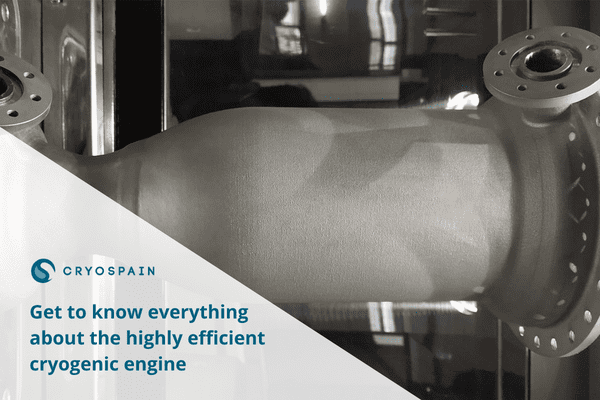The cryogenic engine has become one of the leading efforts as part of the space industry’s quest for increased efficiency and power for their rocket engines. The search for more environmentally-friendly options, as well as extending power capabilities of engines, has seen in the cryogenic field a priceless ally ready to push this industry’s potential to the maximum.
Endeavors such as the CE-20 represent successful examples of the potential of different cryogenic rocket models, and so does the SABRE project, which incorporates Cryospain’s cutting-edge cryogenic engineering technology.
But what exactly is a cryogenic engine, how does it work and what technologies are opening new doors to the development of state-of-the-art rocket engines? Keep reading to find out.
What is a cryogenic engine?
A cryogenic engine is a type of rocket engine that uses liquefied gasses as fuel and oxidizers. The term cryogenic refers to the fact that these liquefied gasses must be kept at cryogenic temperatures, that is, very low temperatures (below -150 degree Centigrade)
The first instances of cryogenic rockets were seen as part of the US Space Program NASA: the Atlas-Centaur mission, leading the Saturn V rocket to the Moon, used a cryogenic engine.
While different models present diverse functioning modes, a cryogenic engine will typically employ Liquid Oxygen (LOX) and Liquid Hydrogen (LH2) as propellants, instead of conventional rocket fuel options.
Among the advantages of this model (which we’ll see below in more detail) is the fact that a cryogenic rocket engine offers more force per kilogram of propellant, increasing the engine’s efficiency.

Components of the cryogenic rocket engine
- Combustion chamber
- Fuel injector
- Pyrotechnic initiator
- Turbopumps for fuel and oxidizers
- Cryogenic valves
- Regulators
- Fuel tanks
- Rocket engine nozzles
How does a cryogenic engine work?
As opposed to electric motors, whose power comes from rotating motion, cryogenic engines are reaction engines. In order to work, they throw mass in one direction and rely on the reaction thrust in the opposite direction. A small amount of fuel goes to the turbine.
In order to do so, they rely on high mass flow rates of oxidizers and fuel. As we’ve said above, these elements are Liquid Oxygen (LOX) and Liquid Hydrogen (LH2), which need to be stored in specifically-designed cryogenic tanks that are able to maintain temperatures of -183 deg C and -253 deg C.
Additionally, these engines may rely on different types of cycle, including those based in an expander cycle, a gas generator, a staged combustion, or a pressure-fed cycle.
You may like: Revolutionizing the aeronautical industry with liquid hydrogen
Advantages and disadvantages of cryogenic engines
Among the main advantages of cryogenic engines are:
- More environmentally-friendly than other options
- Non-toxic and non-corrosive
- Able to reduce the cost of launch operations
- Efficient and high-specific impulse
- Safer than other options in terms of ground safety, they’re non-hypergolic
The disadvantages of this type of engine include:
- Liquid Hydrogen presents a low density
- Their cryogenic storage requires of complex equipment that must be carefully tailored by experts in cryogenic engineering
- Presents the need for devising an ignition system
Keep reading: How do hydrogen airplanes work?
Cryospain’s projects
Cryospain’s cryogenic engineering expertise was put to the test with our involvement with the SABRE project. This Synergistic Air-Breathing Rocket Engine, devised by the British aerospace company, uses both liquid Helium and Hydrogen to operate.
A state-of-the-art project, it is able to cool incoming air at velocities up to Mach 5.5 from 1000 °C to -150 °C in a fraction of a second. It does so through a heat exchanger, which provides oxygen for mixing with hydrogen for the necessary jet thrust during atmospheric flight. The operation then moves to stored liquid oxygen in space.
Through this project, we provided a state-of-the-art technological solution that had both efficiency and safety in mind. As such, we were able to present them with a pipe-in-pipe system that maximized cryogenic insulation while meeting all project requirements. This configuration has proven successful in a number of fields, including the development of pipe-in-pipe systems for bunkering.
In the case of this cryogenic engine, our solution, which was delivered ahead of schedule, allowed the cryogenic fluids to be transported while retaining their liquid state. In fact, we provided two models for pipes: 38m of DN25 and 20m of DN100.
Through our specialized engineering department, we were able to provide the required 100% accurate calculations and the highest safety standards, helping our partners guarantee that the fluids were transported safely and efficiently, minimizing boil-off.
Want to learn more about current cryogenic rocket engine options and how to have access to the most suitable equipment? Download our free SABRA success story about cryogenic engines or get in touch with our team to discover how we can help you access high quality cryogenic systems that match the needs of your project.











 Contacte-nos
Contacte-nos